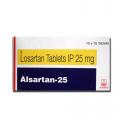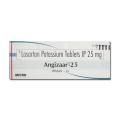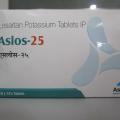Home / Categories / LOSITA-25MG

LOSITA-25MG
(15X10'S)
LOSARTAN-25MG
ANGIOTENSIN RECEPTOR BLOCKERS(ARBS)
NATIONAL HEALTHCARE P. LTD., SPECTRA-DIVISION
Product Details
Losartan Potassium
A to Z Drug Facts
Losartan Potassium
Action
Indications
Contraindications
Route/Dosage
Interactions
Lab Test Interferences
Adverse Reactions
PrecautionsPatient Care Considerations
Administration/Storage
Assessment/Interventions
Patient/Family Education
(low-SAHR-tan poe-TASS-ee-uhm)CozaarTablets: 25 mgTablets: 50 mgTablets: 100 mgClass: Antihypertensive, Angiotensin II antagonist
 Action Antagonizes the effect of angiotension II (vasoconstriction and aldosterone secretion) by blocking the angiotensin II receptor (AT1 receptor) in vascular smooth muscle and the adrenal gland, producing decreased BP.
Action Antagonizes the effect of angiotension II (vasoconstriction and aldosterone secretion) by blocking the angiotensin II receptor (AT1 receptor) in vascular smooth muscle and the adrenal gland, producing decreased BP.
 Indications
Indications
Treatment of hypertension; nephropathy in type 2 diabetic patients.
 Contraindications Standard considerations.
Contraindications Standard considerations.
 Route/Dosage
Route/Dosage
Hypertension
Adults: PO Initial dose: 50 mg once/day; 25 mg once/day if volume depleted or history of hepatic impairment. Maintenance: 25 to 100 mg/day.
Nephropathy in Type 2 Diabetes
Adults: PO Initial dose: 50 mg once daily; the dose may be increased to 100 mg once daily based on BP response.
 Interactions
Interactions
Lithium
Plasma concentrations may be increased by losartan, resulting in an increase in the pharmacologic and adverse effects of lithium.
 Lab Test Interferences None well documented.
Lab Test Interferences None well documented.
 Adverse Reactions
Adverse Reactions
CNS: Dizziness; insomnia. EENT: Nasal congestion. GI: Diarrhea; dyspepsia. RESPIRATORY: Cough; sinusitis. OTHER: Muscle cramps; myalgia; back pain; leg pain.
 Precautions
Precautions
Pregnancy: Category D (second and third trimester); Category C (first trimester). Can cause injury or death to fetus if used during second or third trimester. Lactation: Undetermined. Children: Safety and efficacy in children younger than 18 yr not established. Renal function impairment: Use caution in treating patients whose renal function may depend on the activity of the renin-angiotension-aldosterone system (eg, patients with severe CHF). Hepatic function impairment: Losartan total plasma clearance is lower (50%) and total bioavailability is higher (2-fold) in patients with hepatic insufficiency as compared with healthy subjects. A lower initial dose is recommended for patients with a history of hepatic impairment. Hypotension/Volume-depleted patients: Symptomatic hypotension may occur after initiation of losartan in patients who are intravascularly volume depleted (eg, those treated with diuretics). Correct these conditions prior to administration of losartan or use a lower starting dose. African-Americans: Losartan may not be as effective in African-Americans.
PATIENT CARE CONSIDERATIONS
 Administration/Storage
Administration/Storage
- Administer alone or in combination with other antihypertensives.
- Administer with caution and reduce dosage in patients with possible depletion of intravascular volume or a history of hepatic impairment.
- Can be administered with or without food.
- Do not administer to pregnant women as fetal and neonatal morbidity and death can occur.
- Safety has not been established for nursing infants and children.
- Store in tightly closed, light-resistant container at room temperature.
 Assessment/Interventions
Assessment/Interventions
- Obtain patient history.
- Monitor BP and pulse. Should hypotension, tachycardia, or bradycardia result, withhold the medication and notify the health care provider.
- Monitor for signs of hypersensitivity including angioedema involving swelling of the face, lips, and tongue.
OVERDOSAGE: SIGNS & SYMPTOMS Hypotension, tachycardia
 Patient/Family Education
Patient/Family Education
- Instruct patient to take the medication as prescribed at the same time each day.
- Inform patient that losartan controls, but does not cure, hypertension.
- Caution patient to take the dose exactly as prescribed and not to stop taking the medication even if they feel better. Instruct patient not to decrease or increase the dosage.
- Instruct patient in BP and pulse measurement skills. Caution patient to call health care provider should abnormal measurements occur.
- Instruct patient in methods of fall prevention including rising slowly and sitting on the side of the bed before standing, especially early in therapy.
- Inform patient of the importance of adjunct therapies such as dietary planning, regular exercise program, weight reduction, low sodium diet, smoking cessation program, alcohol reduction, and stress management.
- Instruct patient to report symptoms of weakness, fatigue, dizziness, or lightheadedness to health care provider.
- Caution patient to notify health care provider or dentist prior to surgery or treatment.
- Caution women to contact health care provider if pregnant, planning to become pregnant, or breastfeeding.
Books@Ovid
Copyright © 2003 Facts and Comparisons
David S. Tatro
A to Z Drug Facts



